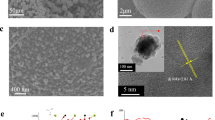Abstract
Silicate-iron oxyhydroxide complex formed by mineral weathering has an important influence on the geochemical reactions of heavy metals in mining areas. In this work, tailings were collected from an abandoned iron tailings pond, and the physicochemical properties and distribution of heavy metals were studied under natural weathering and hydraulic processes. The results showed that Fe2+ in the iron tailings were transported to the surface during the weathering process, and then the iron oxyhydroxide formed by mineralization adsorbed Cu2+ and Zn2+. Silicic acid and exchangeable acid were released during the formation of binary agglomerates between hydroxy iron oxide and kaolin, then they migrated to the lower area of a tailing pond via surface runoff. Finally, silicate-iron oxyhydroxide complex were formed. The heavy metals were replaced by H+ and penetrated to the bottom layer with water. This research provides an important scientific basis for the prevention and control of heavy metal pollution in mining areas.




Similar content being viewed by others
References
AASHTO (2008) Standard method of test T-88-00. Particle Size Analysis of Soils, Washington DC
Bari ASMF, Lamb D, Choppala G, Bolan N, Rahman MM (2020) Geochemical fractionation and mineralogy of metal(loid)s in abandoned mine soils: insights into arsenic behaviour and implications to remediation. J Hazard Mater 399: 123029
Cornell RMSU, Schwertmann U (2003) The iron oxides: structure, properties, reactions, occurrences and uses. Wiley, New York
Cudennec Y, Lecerf A (2006) The transformation of ferrihydrite into goethite or hematite, revisited. J Solid State Chem 179:716–772
Ferras Y, Robertson J, Swedlund PJ (2017) The application of raman spectroscopy to probe the association of H4SiO4 with iron oxides. Aquat Geochem 23(1):21–31
Greenland DJ (1975) Charge characteristics of some kaolinite-iron hydroxide complex. Clay Miner 10(6):407–416
Hayashi S, Ueda T, Hayamizu K, Akiba E (1992) NMR study of kaolinite. 1. Silicon-29, aluminum-27, and proton spectra. J Phys Chem 96:10922–10928
Kanematsu M, Waychunas GA, Boily J-F (2018) Silicate binding and precipitation on iron oxyhydroxides. Environ Sci Technol 52:1827–1833
Kim HJ, Kim Y (2020) Schwertmannite transformation to goethite and the related mobility of trace metals in acid mine drainage - sciencedirect. Chemosphere 269, 128270
Komadel P, Madejová J, Janet M, Gates WP, Kirkpatrick RJ, Stucki JW (1996) Dissolution of hectorite in inorganic acids. Clays Clay Min 44:228–236
Kosmulski M (2016) Isoelectric points and points of zero charge of metal (hydr) oxides: 50 years after Parks review. Adv Colloid Interfac 238:1–61
Li F, Fan Z, Xiao P, Oh K, Ma X, Hou W (2008) Contamination, chemical speciation and vertical distribution of heavy metals in soils of an old and large industrial zone in Northeast China. Environ Geol 57:1815–1823
Li M, Liu H, Chen T, Wei L, Wang H (2019) The transformation of α-(Al, Fe)ooh in natural fire: effect of al substitution amount on fixation of phosphate. Chem Geol 524:368–382
Li P, Lin C, Cheng H, Duan X, Lei K (2015) Contamination and health risks of soil heavy metals around a lead/zinc smelter in southwestern China. Ecotox Environ Safe 113:391–399
Li S, Zhao B, Jin M, Hu L, He Z (2020) A comprehensive survey on the horizontal and vertical distribution of heavy metals and microorganisms in soils of a Pb/Zn smelter. J Hazard Mater 400
Martinez V, Oscar C (2011) Effects of acid mine drainage on the release of aluminum from clay minerals. Dissertation, University of Pittsburgh
Rodríguez L, Ruiz E, Alonso-Azcarate J, Rincon J (2009) Heavy metal distribution and chemical speciation in tailings and soils around a Pb-Zn mine in Spain. J Environ Manage 90:1106–1116
Shaw SA, Hendry MJ (2009) Geochemical and mineralogical impacts of H2SO4 on clays between pH 5.0 and -3.0. Appl Geochem 24:333–345
Smoke JD (2007) Preliminary design of a treatment system to remediate acid rock drainage into Jonathan Run. Dissertation, University of Pittsburgh
Spitz K, Trudinger J (2019) Mining and the environment: from ore to metal. Int J Min Reclam Env 23:241
Stumm W, Morgan JJ (1981) Aquatic chemistry: an introduction emphasizing chemical equilibria in natural waters. Wiley, New York
Swedlund PJ, Miskelly GM, Mcquillan AJ (2010a) Silicic acid adsorption and oligomerization at the ferrihydrite-water interface: interpretation of atrir spectra based on a model surface structure. Langmuir 26:3394–3401
Swedlund PJ, Miskelly GM, McQuillan AJ (2010b) Silicic acid adsorption and oligomerization at the ferrihydrite-water interface: interpretation of ATR-IR spectra based on a model surface structure. Langmuir 26(5):3394–3401
Tabelin C, Sasaki A, Igarashi T, Tomiyama S, Villacorte TM, Ito M, Hiroyoshi N (2019) Prediction of acid mine drainage formation and zinc migration in the tailings dam of a closed mine, and possible countermeasures. MATEC Web of Conferences, 268
USEPA (2004) Method 9045D: soil and waste pH, part of test methods for evaluating solid waste, physical/chemical methods. Environmental Protection Agency Publication, Washington, DC. https://www.epa.gov/sites/production/files/2015-12/documents/9045d.pdf. Accessed 11 Sept 2020
Wei S, Tan W, Zhao W, Yu Y, Liu F, Koopal LK (2012) Microstructure, interaction mechanisms, and stability of binary systems containing goethite and kaolinite. Soil Sci Soc Am J 76:389–398
Yin H, Tan N, Liu C, Wang J, Liang X, Qu M, Feng X, Qiu G, Tan W (2016) The associations of heavy metals with crystalline iron oxides in the polluted soils around the mining areas in Guangdong province, China. Chemosphere 161:181–189
Acknowledgements
We gratefully appreciate the financial support of the National Key Research and Development Project of China (2018YFC1802603) and the National Natural Science Foundation of China (41761072).
Author information
Authors and Affiliations
Corresponding author
Supplementary Information
Below is the link to the electronic supplementary material.
Rights and permissions
About this article
Cite this article
Zhao, Q., He, J., Yan, X. et al. Formation Process of Silicate-Iron Oxyhydroxide Complex and Its Influence on the Distribution of Heavy Metals in Mining Area. Bull Environ Contam Toxicol 107, 990–995 (2021). https://doi.org/10.1007/s00128-021-03300-w
Received:
Accepted:
Published:
Issue Date:
DOI: https://doi.org/10.1007/s00128-021-03300-w




